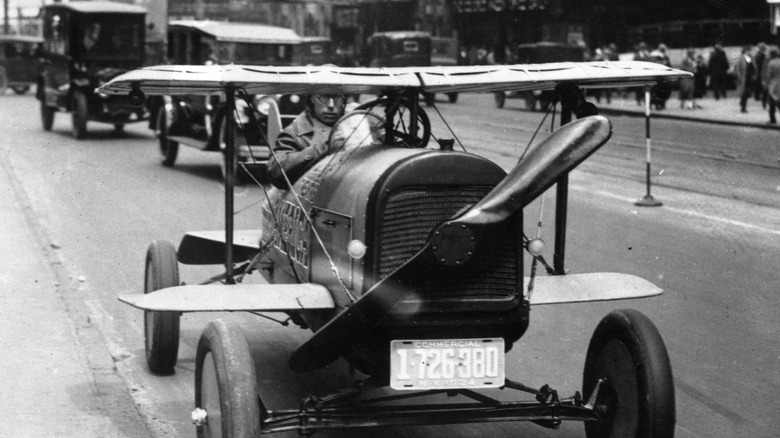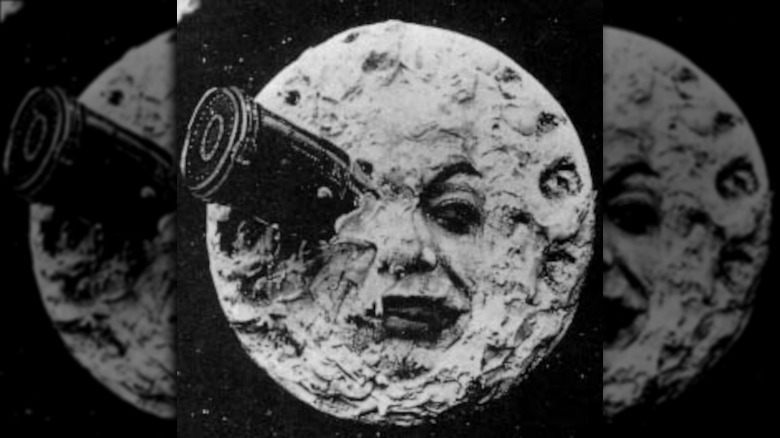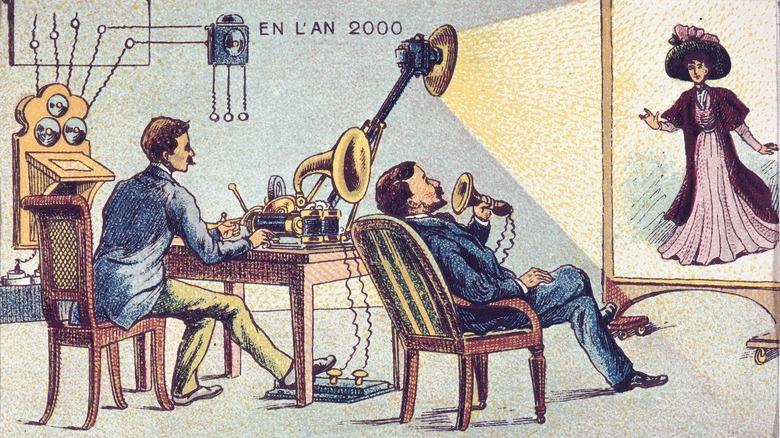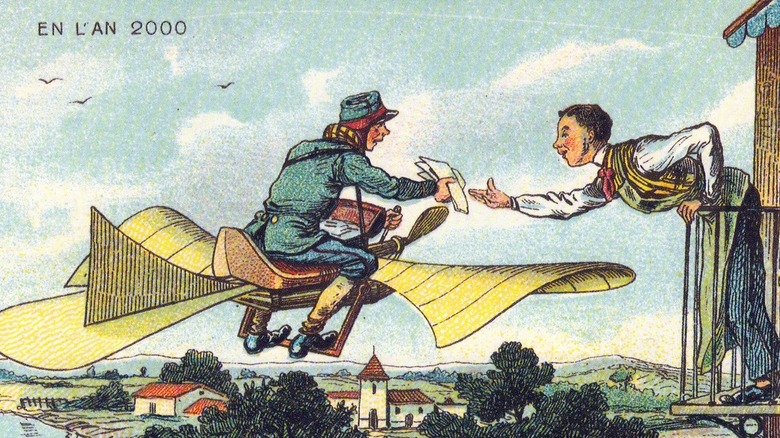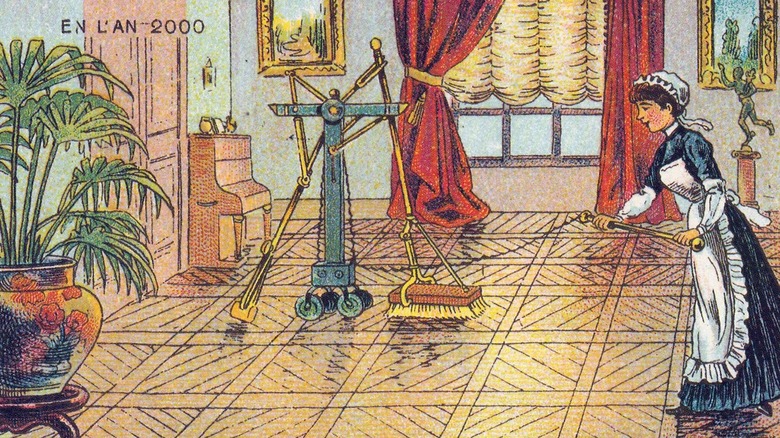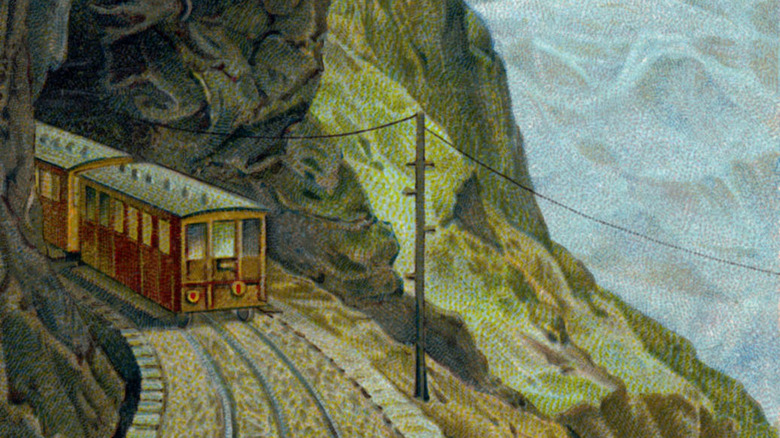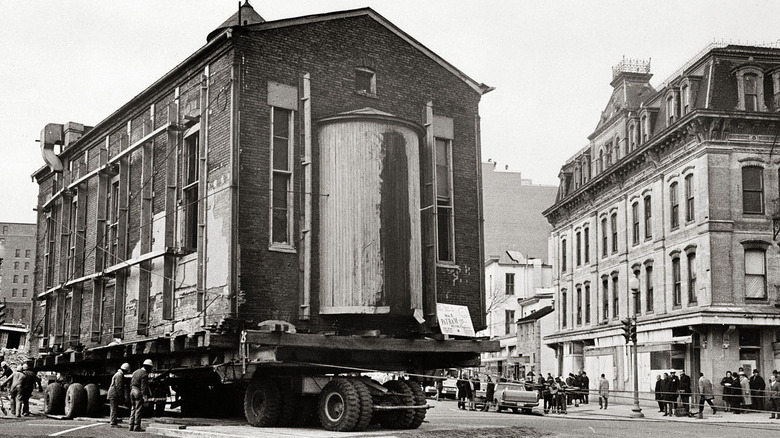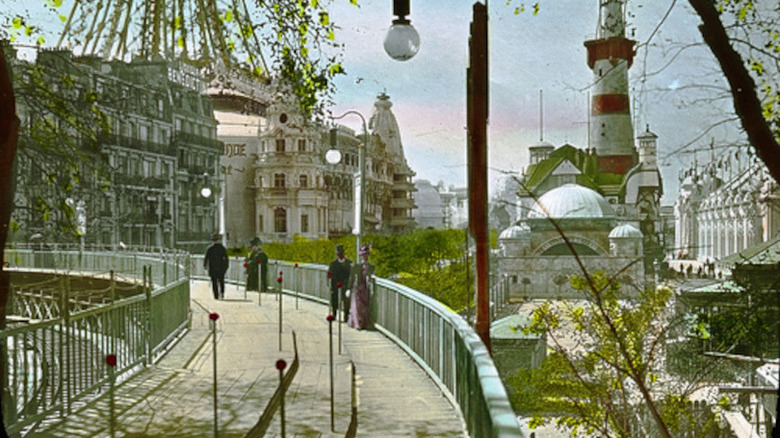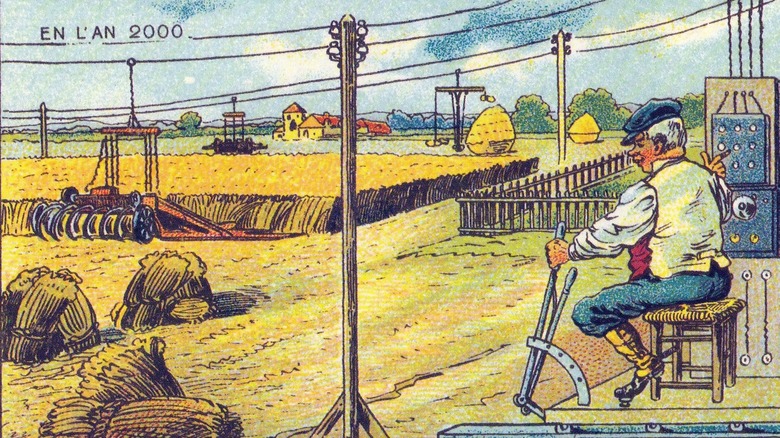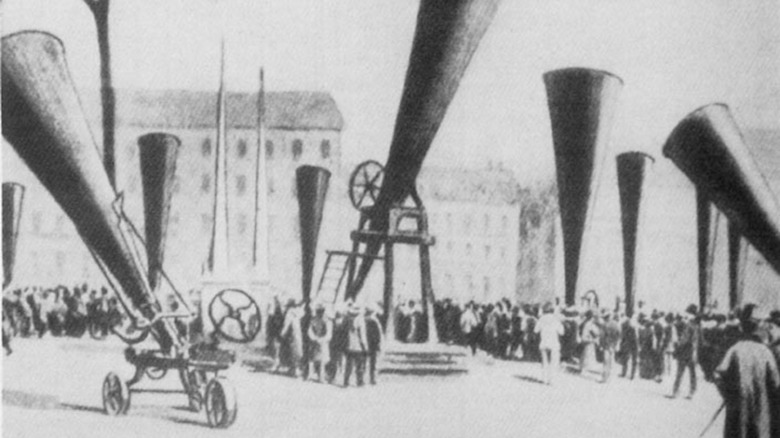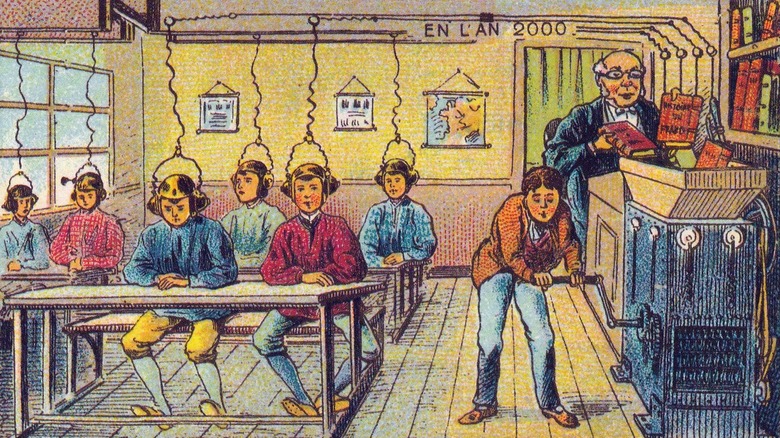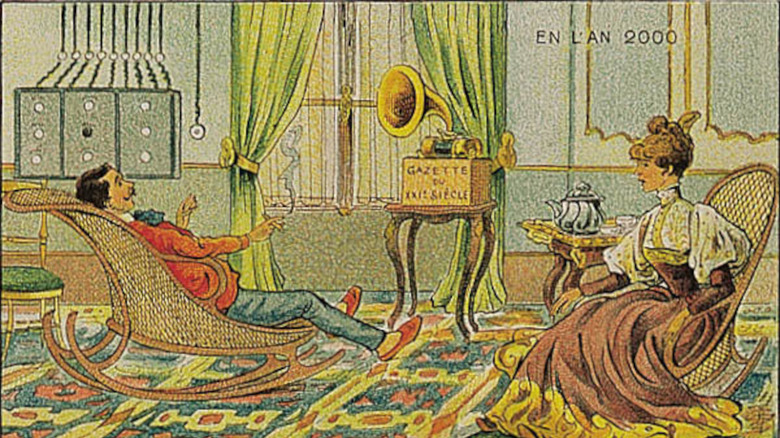How People From 100 Years Ago Pictured The Future Would Be
The prediction business is a perilous one. There's a reason the people who try to predict the future usually hedge their bets behind flowery, easily misunderstood language. Nostradamus still gets name-checked because no one can understand anything he wrote, making it possible to twist his predictions into any shape necessary for accuracy.
That doesn't stop people from trying to predict how things will be. The folks living about a century ago sure weren't shy about imagining the future world, and they had some amazing ideas. Some actually came true (in one way or another), while others remain out of reach. Some of their predictions were also just plain crazy—there was, for example, a strange obsession with living underwater and possibly riding enormous seahorses.
What's fascinating isn't the accuracy of what people from around 100 years ago thought, but what it says about our collective optimism. Dystopian sci-fi may get all the attention, but when you look at what people were actually predicting for the early 21st century, it's a pretty exciting scene. Here's how people from 100 years ago pictured the future would be.
Routine travel to the moon
It's probably not too surprising that folks at the turn of the century and a bit beyond were confident the moon would be an easy destination. As Nature points out, people have been telling stories about traveling to and living on the moon for thousands of years.
The common thread in many of these stories is the confident assumption that travel to and from the moon would eventually be commonplace. How We Get to Next notes that in 1661, Joseph Glanvill predicted that travel to the moon would someday be as easy as sailing to America (which, to be fair, wasn't all that easy back then). And Insider points out that in 1865 Jules Verne published "From the Earth to the Moon," which described an extraordinarily accurate procedure for launching a spaceship to Earth's moon.
So when Wired reports that a series of illustrated postcards from a little more than a century ago depicted flying taxis—powered by propellers!—that would take people to the moon, it's not surprising. What is surprising is that it assumes you'd take your kids to the moon the same way you pack up the station wagon and head for the nearest National Park—including luggage strapped to the roof. Interestingly, according to BBC News just a few years later in 1930, F.E. Smith predicted we'd be traveling to Mars in just a few years—but that we'd miss the first few times, leaving a "half dozen" astronauts drifting in space.
Video phones
According to Wired, a hundred years ago one of the predictions people were making was the widespread use of video phones. That's right, before we even had airplanes people were predicting Zoom. One delightful postcard from the early 20th century shows a fancy lady in Paris chatting with a man in what could be China. Creative Bloq shows a similar scene with a man relaxing as he chats with a woman projected on a screen.
The technology is very steampunk—gramophone horns, old-timey telephone receivers—but the idea wasn't crazy. New York Magazine notes that Nikolai Tesla predicted video conferencing in 1926, and as noted by Time, video calling was first demonstrated just a year later in 1927. The idea that in a few more decades video calls would be routine and easily accessible must have seemed pretty sensible a hundred years ago.
And as noted by The Verge, the video phone has been a constant presence in science fiction films and stories. The video phone enjoyed a unique position in pop culture: It was futuristic because we didn't have them, but the technology absolutely existed so it was possible. Now of course we want to invent time travel so we can go back 100 years and tell people about Zoom Fatigue.
Flying cars, taxis, and people
As noted by Interesting Engineering, flying cars have been a mainstay of science fiction and futurology—so much so that our lack of flying cars has become a meme underscoring our lack of progress. Mentioning that we still don't have flying cars is shorthand for disappointment in the future we did get, and as Fast Company notes, if you were to ask people today about 100 years in the future, you will invariably hear about all the sick flying cars we'll be tooling around in.
The history of this desire for flying cars goes back—way back. As Wired reports, a series of postcards from the Victorian era depict not just flying taxis but flying bird catchers and flying chimney sweeps. Creative Bloq points out that a separate series of old postcards shows flying postal workers delivering the mail, too. A little less than a century ago, F.E. Smith predicted that folks would be using personal flying machines to zoom around the world, making it possible to travel from London to Greenland for a skiing trip on the spur of the moment according to BBC News.
We might actually be getting there. According to The New York Times, there are plenty of companies working on small, electric aircraft that can take off and land without a runway. If they perfect them, and get regulatory approval, we might really have flying cars someday soon.
Robots everywhere
Although the concept of artificial beings goes back to our earliest history, Quartz tells us that the term "robot" entered the lexicon around 1921. That's when Czech writer and philosopher Karel Čapek wrote his play "Rossum's Universal Robots." The play, which focused on themes of dehumanization at the hands of the increasing mechanization of the world, took the Czech word for "forced labor," robota, which itself stems from the Slavic word for "slave."
But as Wired reports, most of the world missed the memo from Čapek and immediately began imagining the future as a glorious one in which robots cut our hair and, according to Fast Company, many also foresaw a world in which robots cleaned our houses. Today, of course, robots do clean some of our houses, though the Roomba is nowhere near as cool as the spidery machines depicted in turn-of-the-century postcards.
Not everyone thought robots would be great, though. BBC News notes that in 1930, F.E. Smith predicted the future would be largely mechanized, relieving us of the need to work long hours—but also thought that would result in severe boredom, leaving us very unfulfilled. But then Smith also thought we'd routinely be living to be 150 years old, making it difficult for younger folks to find jobs when geezers in their 120s were still in their prime, but rocking a lifetime of experience.
Super fast trains
Around a hundred years ago automobiles had just been introduced and wouldn't become common for a while. So it's understandable that few futurists nailed the modern car-centric world. It also makes sense that a lot of predictions for the future focused on trains. Trains were how people got around back in those days, so people naturally thought of the future in terms of trains—just way faster trains.
BBC News reports that in 1900, an engineer named John Elfreth Watkins published an article predicting what life in the 21st century would be like. One of his predictions that basically came true was the introduction of high-speed trains that could top 120 MPH. As Business Insider points out, the Acela express train in the U.S. can hit 150 MPH, and Japan has bullet trains that can get close to 200 MPH.
According to Wired, some train-based predictions combined the nascent automobile with trains to imagine a kind of hybrid. One postcard from the turn of the century shows a couple tearing along a train track in an open carriage of sorts, alarming passers-by with their incredible speed. As Hemmings Motor News reports, luxury car maker Bugatti actually produced Autorails, individually-powered train cars, during the Great Depression when demand for incredibly expensive automobiles cratered. These could hit speeds of 120 MPH in the early 1930s.
Moving cities and towns
The one unbreakable rule of cities and towns is that if you want to live there, you have to be the one doing the traveling. New York City is not going to get up and move closer to you. But according to Interesting Engineering, back in 1900 one artist predicted that entire cities might be loaded onto a platform and moved around via locomotive. They were even bold enough to put a date on their prediction, deciding that this would be a reality by 2000.
Moving an entire town would have advantages. Floods could be avoided, and citizens could enjoy nice weather all year round simply by voting where their city would drive off to next. But so far, it's not exactly common to see an entire town floating down the highway—though it isn't uncommon to see whole buildings being moved via truck or rail.
And according to Gizmodo, we actually have moved entire towns, though usually this involves either taking all the structures apart and re-assembling them somewhere else, or simply re-creating the town in the new location. One example gets close to what was predicted back in 1900, however: According to Hibbing History, the town of Hibbing, Minnesota, relocated after a mining company discovered iron ore directly underneath the existing town. They literally put the buildings on rollers and tugged them via tractor to a new location some miles away.
Cities covered by domes or roofs
To paraphrase Montgomery Burns, since the beginning of time, man has yearned to destroy the rain. The idea of putting a dome or roof over our cities to either block or somehow control the weather was a surprisingly popular one a hundred years ago. Interesting Engineering points out that one of a series of popular postcards from a century ago depicting life in the 21st century shows an entire city covered by a massive roof. The roof keeps the rain off while providing light via enormous electric lamps.
As noted by Paleofuture, the idea persisted. In 1949, an academic published an article suggesting that New York City could be placed under a roof that could be used to control the weather directly, and helpfully provided an illustration to show what it might look like. IBM notes that Buckminster Fuller suggested doming Manhattan in the 1960s, and in the 1970s a futurist named Athelstan Spilhaus actually got kind of close to creating a domed city in Minnesota called the Minnesota Experimental City before local opposition shut down the project.
As charming as those old postcards are, we're no closer to domed cities than we were in 1900 or 1921. Today most engineers put their efforts into making the buildings in cities smarter and more environmentally-friendly.
People movers instead of sidewalks
If there's a theme in the predictions for the future people made a century ago, it might be laziness: Aside from personal flying machines and labor-saving robots, they also really, really thought our cities would be equipped with moving sidewalks. According to Entrepreneur, in 1921 a writer named Moses Folsom predicted all cities would be equipped with them. This would, of course, reduce all that annoying exercise we get by having to walk from our house to the grocery store.
As noted by Gizmodo, there's a good reason so many people thought moving sidewalks were the future: They were something of a fad in the late 19th and early 20th centuries. Examples popped up at the 1893 World's Fair in Chicago, and another one at the 1900 World's Fair in Paris which was more than two miles long. In fact, according to Paleofuture, the Paris moving sidewalk was filmed by none other than Thomas Edison. It moved along at a brisk six miles per hour, with a slower lane and a stationary lane allowing for a graceful entrance and exit.
Smithsonian Magazine reports that interest in moving sidewalks returned in the 1920s, but despite constantly being brought up as part of the city of the future, they were never widely adopted. But, of course, you can find moving sidewalks at places like theme parks and airports.
Mechanized farms – with force-grown livestock
According to the U.S. Census Bureau, there are close to 8 billion people in the world today, which is a lot of mouths to feed. Interesting Engineering explains that the only reason we're able to feed ourselves is thanks to mechanized farming at a huge scale.
The world was a smaller place a hundred years ago, and farming was more small-scale and dominated by small individual farms. But according to The Washington Post, when it came to predicting the future people got pretty close in terms of farming. One of the paintings produced as part of a series called "France in the Year 2000" shows a happy farmer remote-controlling a tractor as it works his fields. Another shows a woman feeding eggs into a machine that spits out hatched chicks on the other end. As noted by Creative Bloq, the latter image is pretty close to some of the techniques used in "battery farmed" chickens in the modern age.
One curious aspect of these predictions is that as incredible as the machines must have seemed to people 100 years ago, they are all depicted as requiring a human being to operate them with levers and other controls. The idea of automation was obviously too far out.
Controlling the weather
The idea that someday we'll be able to control the weather is obviously a powerful one. If you've ever watched your crops die for want of rain or stared in horror as floodwaters invade your home, you'd probably vote to fund a weather-controlling machine. The idea was popular among futurists a hundred years ago. According to Paleo-Future, included among a series of postcards released in 1900 depicting life in the 21st century is one showing a weather control machine. Moving along a track, it appears to be changing a rainy day into a bright, sunny one.
The idea wasn't totally crazy. According to How Stuff Works, in 1891 the United States government paid good money to a guy named Robert Dyrenforth to test whether or not rain could be generated in Texas. The results were unsurprisingly inconclusive. Smithsonian Magazine notes that in the 1950s scientists thought they were on the verge of being able to influence the weather, and put some thought into how that could be weaponized.
Today the dream of flicking a switch and watching the clouds vanish or the rains pour lives on. According to Forbes, China has leaned into rain-making machinery in a big way, installing cloud-seeding equipment across vast stretches of its country. While it's not quite as fancy as the machines imagined a hundred years ago, it's a start.
Machine learning ... literally
Anyone who has ever fallen asleep during a particularly boring class, or stared with increasing panic at a blank final examination has imagined there must be a better way to learn. Folks living a century ago thought the same way. The Washington Post points out that among a series of 1900 postcards depicting the 21st century is one showing students in a classroom. They're wearing what look suspiciously like earphones, or perhaps telepathic caps of some sort. The craziest part? A cheerful teacher is pouring books into a machine while a student turns a crank, implying the books are ... somehow ... crushed into electric knowledge? Or simply being destroyed as unnecessary any more, maybe.
As noted by Smithsonian Magazine, this aligns with other predictions about the future of education. An article written by Thomas F. Anderson in 1900 predicted that education would become more egalitarian in the future, more "universal" and less "aristocratic." Knowledge pumped directly into the brains of children would certainly help with that.
Futurism notes that one prediction about education from a hundred years ago certainly didn't come to pass. In 1900, John Elfreth Watkins Jr. wrote that physical education would start "in the nursery" and that most everyone would be capable of walking 10 miles with ease. While we do have physical education in most schools, we're certainly not churning out super men and women.
Netflix and chill
Plenty of people have wondered how in the world people entertained themselves 100 years ago, when at-home entertainment was extremely limited. One way they managed to amuse themselves was clearly imagining a better world, because a lot of predictions from the early 20th century involved home entertainment.
As noted by Gizmodo, in 1921, inventor and mathematician Charles P. Steinmetz published an article making some predictions for the future, and he nailed it, writing, "There will be no need to go to some congested, poorly ventilated hall for a musical concert ... Music will be supplied by a central station and distributed to subscribers ... while sitting in our libraries at home."
Paleofuture reports a series of postcards from the year 1900 that go even further, predicting that not just music, but moving images will be beamed right into our homes. The fact that video is depicted like a projected movie makes sense, as that technology was known at the time and would have seemed very cutting-edge. And in another postcard (via The Washington Post), a concert is shown being enjoyed in person—but the music is being provided by an automated band, controlled by a conductor who's more like a 1900s DJ, pushing buttons and pulling levers.
